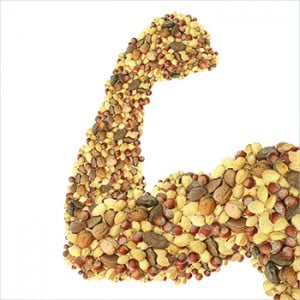The Important Science Behind Gaining Muscle

If you lift weights, there's a good chance you are trying to gain muscle. Gaining muscle is arguably the most sought after effect of lifting heavy things up and putting them down.
Gaining muscle does more than just make you look bulky and sexy. For athletes, added muscle will improve performance by increasing strength, power and bodyweight. For the more general population, increasing the size of your muscles, known as hypertrophy, can increase function by making your daily activities easier, adding years of independence, and even helping in fat loss efforts. Remember, muscle is a metabolic tissue so the more muscle you have, the more calories you burn - particularly during exercise.
There's no shortage of workouts available online and in magazines that promise to add six inches to your biceps in just six seconds, but how do you know if they are actually affective?
What you need to know is how hypertrophy happens, what causes it, and what kind of stimulus (programming) sparks your muscle to adapt by getting bigger.
How Do Your Muscles Get Bigger?

The answer lies in protein synthesis. In order to gain muscle you must synthesize more protein than you break down. This means you have a positive protein balance. This is the basis for building muscle. Protein is the building block of muscle which means you must have an excess of it to build muscle. When your muscles break down from lifting weights, your body uses protein to build them back up even stronger than before to avoid injury.
This happens in different ways, but the primary mechanism is by adding more sarcomeres side by side (technically known as "in parallel"). Sarcomeres are the functional part of your muscles that contain the proteins actin and myosin which interact via a process known as the sliding filament theory to shorten your muscles.
The more sarcomeres your muscles have, the bigger they become and the stronger they get as a result of an increase in your muscles' cross-sectional area; in other words, its diameter. Think of it as stuffing a bunch of raw spaghetti into an expanding container. The more you stuff in there, the wider it gets.
This all occurs within individual muscle cells known as myofibers. This means that you are not actually adding muscle; you're just making them bigger. So the next time your buddy brags about how much muscle he's gained you can deflate his ego a little bit by proving him wrong. Too bad you can't deflate his muscles a little too, right?
What Causes Your Muscles to Get Bigger?
We know that protein synthesis is responsible for making your muscles look like inflated balloons, but what provides the stimulus to cause the muscle to adapt this way? The answer should be obvious - strength training!
So, let's take it a step further.
A research review in 2010, performed by renowned muscle hypertrophy researcher Brad Schoenfeld, found that research points to three main mechanisms that cause muscle hypertrophy: 1) mechanical tension, 2) muscle damage and 3) metabolic stress. Let's take a look at what causes each of these and how they affect muscle hypertrophy.
Mechanical tension refers to the amount of force (tension) that is developed by your muscle fibers in response to a stimulus. In this case, the stimulus is the weight/force we are pushing and pulling against when strength training. This is referred to as external force.

The more weight/external force you use in an exercise, the more tension (internal force) your muscles will have to produce. It should also be noted that not all muscle fibers are used during an exercise, and if a muscle fiber is not used, it has no incentive to get bigger.
The good news is that using heavy weights will force your brain to recruit more muscle fibers in order to create enough tension to handle the monstrous loads you are imposing on them. This doesn't mean you need to use maximal loads however. Even moderate loads as low as 60% of your 1 rep max can produce enough stimuli for significant muscle recruitment.
According to Dr. Brad Schoenfeld, the premise of mechanical tension's ability to stimulate muscle growth is that when resistance is applied to, and sensed by, a muscle, there is a concurrent chemical signal sent to the brain that results in an increase in protein synthesis, which is the basis for muscle hypertrophy.
Muscle damage is simply the breakdown of muscle tissue. When your muscle breaks down your body builds it back up even stronger than it was before. Your body is pretty smart, isn't it?
It is caused predominantly during eccentric contractions. During an eccentric contraction, your muscle elongates while exerting a braking action to resist the pull of external forces. This causes small tears in the muscle. When extreme loads are used, this braking action is often referred to as "negatives," and is often employed by bodybuilders.
Muscle damage causes hypertrophy in a few different ways:
- One, it activates satellite cells which are dormant cells that act when called upon. When a muscle fiber is damaged, a satellite cell is activated to repair the damaged fiber. In doing so, it donates a nucleus (cell brain) to the damaged muscle fiber which is responsible for producing muscle proteins. This results in an increase in protein synthesis. Therefore, the more nuclei a muscle cell has, the more sarcomeres you have, and the bigger your muscle gets.
- Two, it causes inflammation of the damaged cells. The resulting inflammation causes an influx of macrophages which release agents that promote muscle regeneration (aka increased protein synthesis).
- Three, muscle damage also causes cell swelling. Essentially, a damaged muscle accumulates fluid which stretches the outer layer of the muscle cell (sarcolemma). This results in an increase in protein synthesis and reduces protein breakdown, which are both essential to muscle hypertrophy.
Metabolic stress is an accumulation of metabolites such as lactic acid and inorganic phosphates, among others. This is primarily a result of training to exhaustion. It works similar to muscle damage induced cell swelling except that it causes an influx of plasma (cell fluid) into the muscle cells.
Just as with cell swelling caused by muscle damage, this also increases protein synthesis and reduces protein breakdown. Again, both are necessary to increase muscle mass. Are you starting to see the theme here?
To recap, in order to increase muscle mass you must synthesize more protein than you are breaking down. Anything that prevents you from breaking down muscle protein is a welcome added bonus. Protein synthesis is stimulated by mechanical tension, muscle damage and metabolic stress. The primary way for any (or all) of these to happen is by using moderate to heavy loads during resistance exercise and working to exhaustion.
How to Program Your Workout for Hypertrophy
As previously mentioned, strength training is the primary stimulus for increasing protein synthesis. There are several components of a training program that will affect the protein synthesis response. The most important factors are the ones that will directly affect mechanical tension, muscle damage, and metabolic stress.
Basically this all boils down to training volume, which is simply how much work you perform during a workout and over time (i.e. a week). The factors responsible for influencing work volume are repetitions, sets, rest periods, and frequency.
Most people are familiar with repetitions as it pertains to each given set. For example, you might perform 12 reps per set or 6 reps per set. The number of repetitions per set ranges depending on what you want to accomplish. Generally, repetitions ranging from 1-5 are used to maximize strength gains, 6-12 for strength size, and up to 20 for muscular endurance.
Competitive bodybuilders generally use what has been deemed the "hypertrophy range" of 6-12 reps per set, and for good reason, as research tends to support this. However, it is a good idea to also train using lower rep ranges to increase strength and maximize muscular tension. The strength you gain will allow you to use heavier loads when training for hypertrophy. Heavier loads + more reps = bigger muscles!

The amount of sets you perform for a given exercise affects training volume, as it increases the amount of reps you do. For example, 3 sets of 10 reps will give you a total of 30 reps and by adding another set you will do 40 reps. This means the more sets you do, the better for hypertrophy.
But this isn't a free ticket to do as many sets as you please. Too many sets (too high of training volume) will lead to overtraining, and greatly increase your risk of injury. The key is to maximize stimulus without overtraining. To do this, it is generally recommended to perform 3-5 sets per exercise.
Another key to avoiding overtraining and injury is to progress your training volume by increasing your sets as your tolerance and conditioning allow. If you haven't been exercising for a while (or ever) start off with 2-3 sets and work up to 5 sets over several weeks.
Rest periods, the amount of time you rest between sets, affect how well and how completely your muscles recover from your previous set to the next. This has a big impact on metabolic stress, which, if you recall, affects both protein synthesis and the breakdown of muscle protein.
As with sets, rest periods must be optimized to maximize results and reduce risk of injury. Too much rest will result in a loss of metabolic stress and if you don't rest your muscles long enough, the muscles force production will be negatively affected, which will result in a loss of mechanical tension.
How much rest is ideal? Ultimately, you are responsible for figuring out what works best for you. This may take some trial and error to dial in. However, 1-2 minutes seems to work well for most people.
Lastly, frequency, how often you exercise, affects training volume much the same way sets do. All other factors being equal, two days a week is less training volume than three. However, as with sets, this is not a free ticket to lift weights every single day (more specifically: the same muscle groups every day). Strength training too often will increase your risk of injury, and too infrequent will not provide enough stimulus for adaptation.

Research has shown that strength training even just two days per week is sufficient for hypertrophic gains, but 3 days a week seems to be ideal. It is also highly recommended that you rest your muscles for a minimum of 48 hours between exercise bouts to allow adequate time for your muscle to recuperate (i.e. Monday, Wednesday, Friday). It is also a good idea to progress up to three days a week over time, similar to how you would with increasing the number sets you perform during an exercise.
In conclusion, muscle hypertrophy happens via a few different mechanisms, but really it's a matter of protein synthesis which is stimulated through mechanical tension, muscle damage, and metabolic stress. It should be noted, however, that the best program and any stimulus will be nullified if you do not eat adequate amounts of calories and protein in particular. Without that, you will always have a negative muscle protein balance and it will be impossible to gain muscle mass. See a nutritionist in your area for guidelines on how much protein is right for you.
When creating a training program geared towards hypertrophy, training volume is the key factor for creating the proper stimulus. This can be manipulated by your training frequency, rest periods, sets and repetitions. While there are general guidelines to follow, it is best for you to play around with these to find the best combination that works for you.

